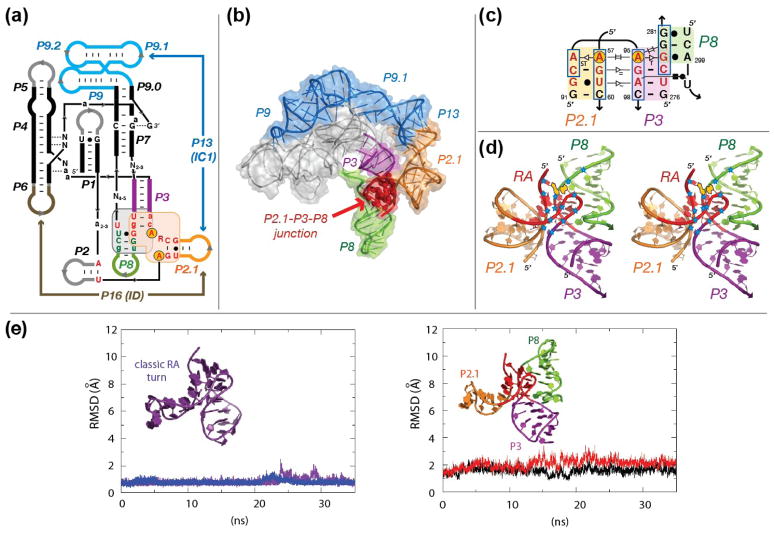Figure 5.
The RA motif in self-splicing group IC1 and ID introns. (a) Secondary structure diagram of the catalytic core of group IC1 and ID introns. P stands for pairings. P3 is in violet. P8 is in green. Capital letters are for positions conserved at more than 92%. Small letters are for positions conserved at more than 85%. The IC1 and ID subgroups share a similar P2.1-P3-P8 junction (sequence signature in red letters) 41. (b) Three-dimensional model of the Tetrahymena ribozyme with the stabilizing peripheral RNA belt consisting of P9.1-P13-P2.1 (see Material and Methods). Same color code as in (a). (c) 2D-diagram of the P2.1-P3-P8 RA junction from the Tetrahymena ribozyme with proposed tertiary interactions. Nucleotides in red correspond to the RA motif. The circled adenine positions (A57 and A95) form a UV-induced crosslink in an active form of the Tetrahymena ribozyme (a group IC1 molecule) 47,48. Boxed nucleotides indicate positions that are protected from Fe(II)-EDTA cleavage in the native Tetrahymena ribozyme 46. (d) Stereo view of the proposed structure for the P2.1-P3-P8 junction of the Tetrahymena ribozyme. Positions protected from Fe(II)-EDTA cleavage are indicated by blue stars. At the exception of one position (nt 281) likely protected by P2 (not shown), the observed protections are best explained by the formation of the RA motif (in red). UV cross-linked adenines 57 and 95 are indicated in yellow. (e) Molecular dynamics (MD) simulations on the classic RA turn (left) and on the modeled RA-2h_stack motif at the P3, P2.1 and P8 junction of group IC1 Tetrahymena intron (right). The classic RA turn structure was extracted directly from the crystal structure of the ribosome and capped with a GNRA tetraloop. Two trajectories of 35 ns simulated at 300°K are shown for both structures. The AAAG_P3_P8 junction is shown to have a relatively comparable rigidity over the course of the simulation at 300°K.

